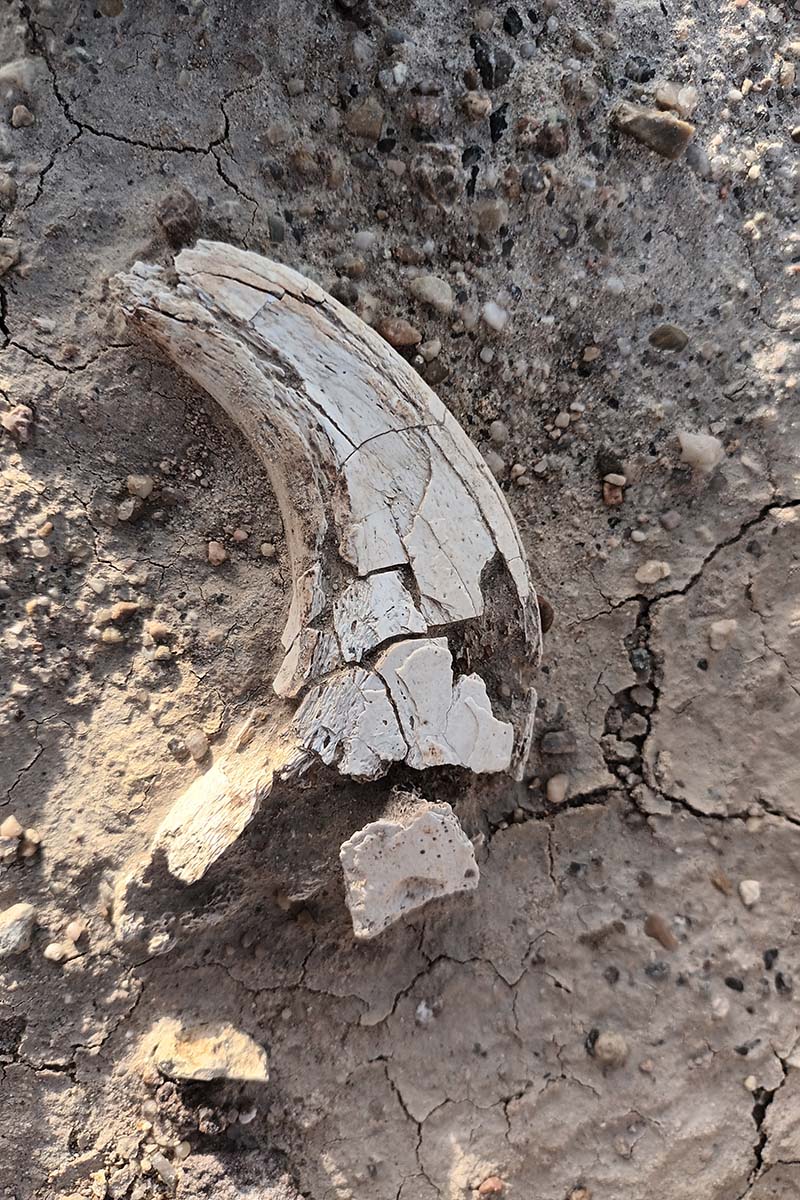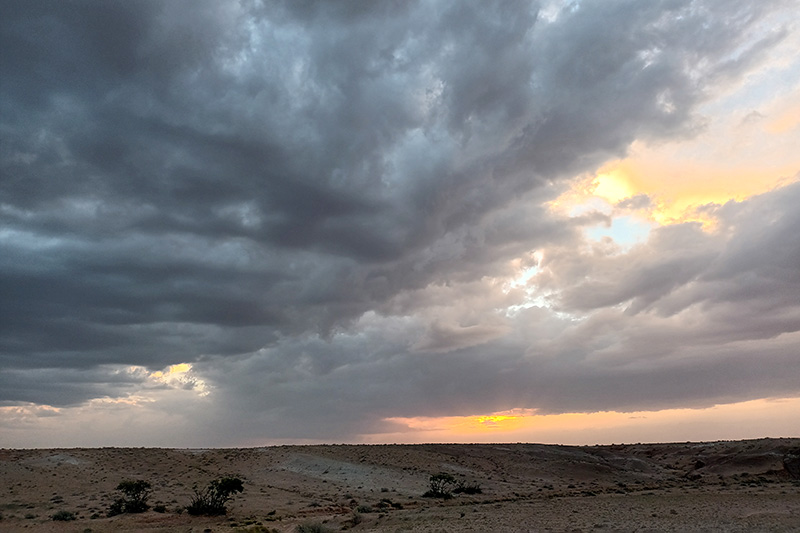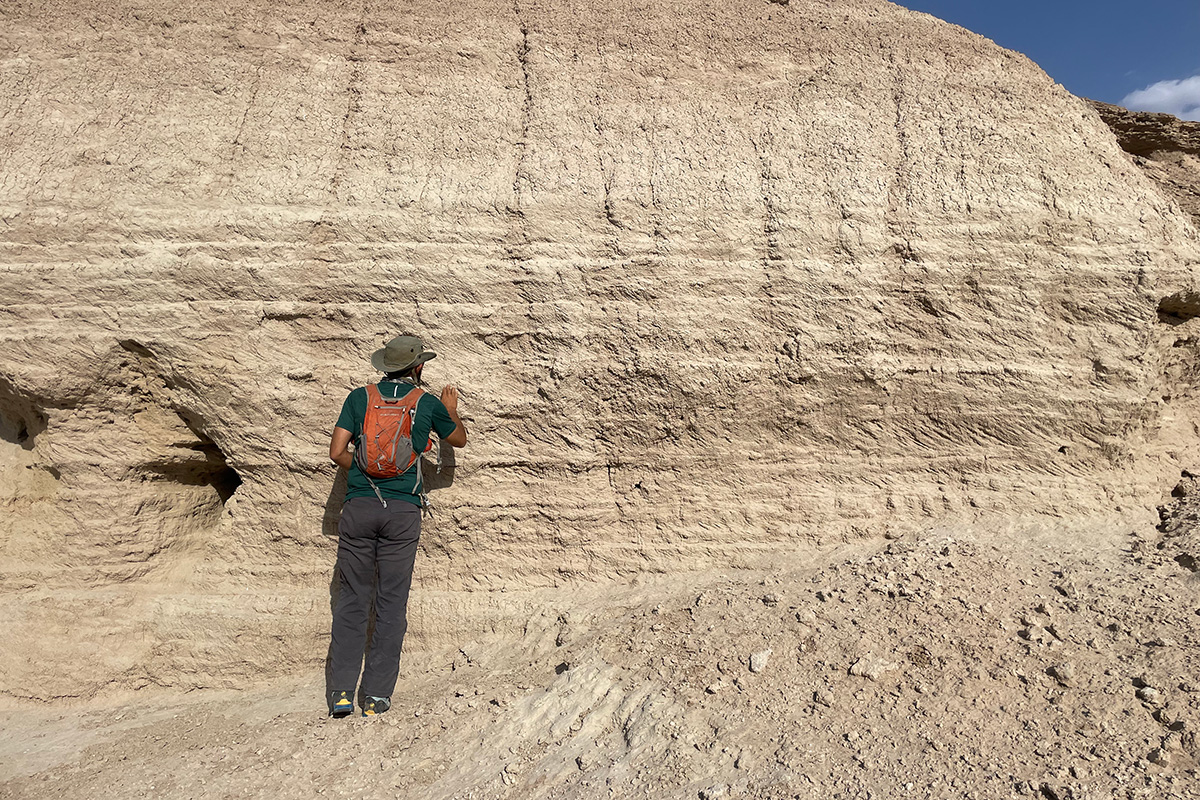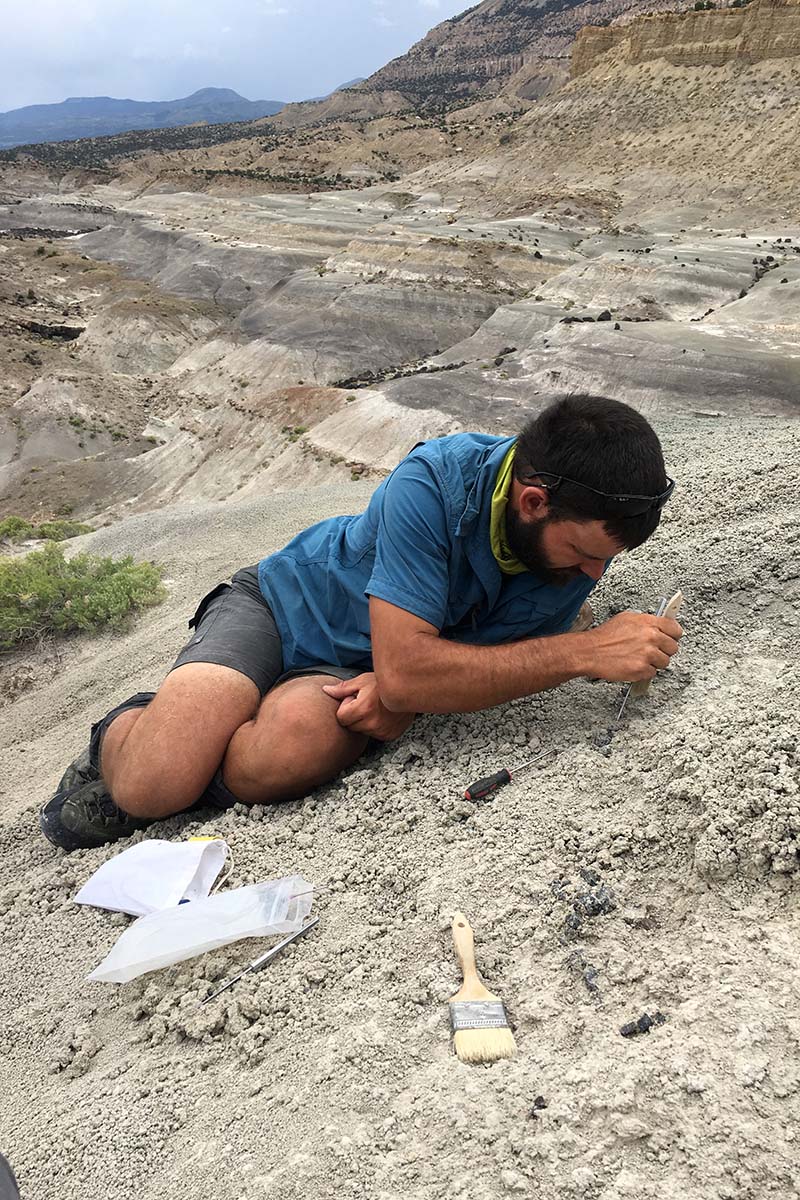Mongolian fossils may shed light on climate change, past and present
Sandra Mulder

A close-up picture of an exposed turtle carapace, taken in the East Gobi Basin in 2022. Photo by Dr Ryan Tucker
The recent discovery of multiple fossil assemblages and ash deposits in the East Gobi Basin in Mongolia could provide new knowledge of the dinosaurs and extreme climate conditions on Earth 120 million to 80 million years ago.
This is according to Dr Ryan Tucker, a sedimentologist and taphonomist (fossilisation expert) in the Department of Earth Sciences at Stellenbosch University (SU). Tucker is a part of an international team of scientists, MADEx (the Mongolian-American Alliance for Dinosaur Exploration), who undertook the expedition that led to the exciting discovery in September and October this year. Under the leadership of Dr Lindsay Zanno of North Carolina State University (NCSU), the MADEx team focuses on finding data on climate change in Earth’s deep time, specifically the Cretaceous period (between 145,5 million and 65,5 million years ago).
Tucker cannot reveal too much information about the discovery, as much of the recovered material belongs to new species yet to be named. “But in broad strokes, we found the fossils of a rather unusually large ankylosaur, what could be an allosaur-type theropod, several new dromaeosaurs (raptors), and one site locality with numerous preserved eggs and egg nests – all roughly from the middle Cretaceous period.
“We are exceedingly happy with the data discovered,” he says.
During the five weeks spent at the Gobi site, the team was surprised to find ash beds, something that had never before been identified in the East Gobi Basin. “This will significantly improve our understanding of Earth’s temporal framework, which currently spans a possible 40 million years. With these specific ash beds, we could improve that age estimate to within the span of 1 million years, which would allow us to meaningfully compare similar dinosaurs, both locally and globally,” Tucker says.
“The data found at the site will provide insights into what we possibly need in order to adapt to climate change in our present time and in the future.
We try to compare the Mongolian fossil assemblages and ecosystems to those of Utah in the USA to test global patterns,” he adds.
Exploring the past and present global climate crises
The recovered fossils, ash deposits and rock material are now at various laboratories in America, Stellenbosch and Mongolia. Scientists are determining, among other things, their age and climate proxies (preserved physical characteristics that enable scientists to reconstruct the climatic conditions, such as the average temperature, humidity and rainfall levels, during a specific time period). The expedition to Mongolia formed part of MADEx’s Cretaceous Terrestrial Ecosystems Project, which aims to fill knowledge gaps by exploring the impact of a global climate crisis on Northeast Asia’s Cretaceous ecosystems.
Previous research has found that Earth’s climate is impacted by the ongoing tectonic processes (earthquakes and the movement of land) and changes in the planet’s crust. Significant historical climate shifts have been linked to these factors.
Recent research indicates that substantial climate change occurred roughly 30 million years ago. Global warming was so intense that rainforests flourished on the South Pole. During this time – dubbed the ‘mid-Cretaceous Thermal Maximum’ (CTM) – Earth’s inhabitants experienced environmental and climatic disruptions due to movements in the planet's crust. More specifically, these changes resulted from the separation of the northern and southern hemisphere landmasses, Laurasia and Gondwana (which later respectively split into North America and Eurasia, and South America, Africa, Antarctica and Australia).
Tucker states that the detrimental effects of climate change currently being felt globally could be linked to both natural causes and humans’ alteration of the natural environment, but more research is needed to confirm it.
“Therefore, our team seeks to fill these knowledge gaps by exploring the impact of a global climate crisis on Northeast Asia’s Cretaceous ecosystems. If we are successful in obtaining sufficient research funds, our research will allow us to better understand the effects of the CTM event in the East Gobi Basin of Mongolia, allowing us to capture palaeoclimate environmental proxies for global comparisons in a modern or future context.”

Exposed therizinosaur ungual found near the famed Shar Tsav track site in the East Gobi Basin | Photo by Dr Ryan Tucker

Dr Lindsay Zanno exposes a mid-Cretaceous turtle carapace in the East Gobi Basin in 2022.
Photo by Dr Ryan Tucker
High risks, high rewards
Tucker plans to return to Gobi next year with postgraduate students, who will benefit significantly from prospecting there. “Besides helping to explain the region’s cryptic geology, they will also be prepared for a very successful and rewarding career because of the unique nature of the fieldwork and the complexity of the geology there.
“I hope to find funding to take the students to Mongolia next year and for many years to come. It holds such a special place in my heart now,” Tucker says.
The Mongolia project team seeks ‘high-risk, high-reward’ areas to do their prospecting. “With the aid of historical geological maps and satellite imagery, we assess areas with good rock exposure, high relief, and lacking human modification,” says Tucker. “In these areas, the risk of not recovering any fossil material is high, but so is the reward if we do find something, because it will typically be new to science.”
The East Gobi Basin is one such a site. According to Tucker, there is still a wealth of data to be found there. “We’ve just scratched the surface, and we’ve barely covered a fraction of the geographical area we intended to. We’ve seen very little of what there really is.”
Tucker’s calling
Tucker’s desire to do the work he does today arose when he was a young boy in a kindergarten in Montana, America. “I have always been fascinated by dinosaurs and similar forms, and vividly remember telling my kindergarten teacher I wanted to dig up dinosaurs.”
At age five, Tucker realised his love for the carnivore Tyrannosaurus rex. “My parents took me to the Denver Science Museum. As the doors opened, a newly mounted T-rex was in the foyer. I stood there for an hour, unable to move, in awe of what I saw. At that exact moment, I knew it was my calling to do work on dinosaurs.
“A few years later, I was lucky enough to take part in a local palaeontological dig at the early age of nine. After that, in my teens, I was able to work in the famed Morrison Formation of Southern Wyoming with Dr Robert Bakker and, after that, the Hell Creek Formation in Montana with Dr Luis M Chiappe of the Los Angeles County Museum of Natural History, a person who set the foundation for my future career in the palaeosciences,” Tucker remembers.
A shift in his interest and move towards sedimentology came about when he, as a teenager, still worked at the Montana site where the famous ‘Thomas the T-Rex’ was excavated. “A geologist from the American Museum of Natural History came and conducted a geological assessment of the locality where we were working,” Tucker recalls. “Dr Lowell Dingus [renowned palaeontologist and author] started to paint an environmental picture around the Tyrannosaurus skeleton we were excavating. The remains were entombed within a river channel, with bones sorted based on size and weight due to the energy of the current. Lowell pointed out the riverbank, which had preserved evidence of bioturbation (worms and insects churning up the sediment), and the adjacent floodplain filled with the remains of a complex ecosystem of flora and fauna. The picture he painted that day got me hooked and has stayed with me ever since,” Tucker says.
The experience on that landmark day made him realise that a fossil’s environment holds just as important information as the fossil itself, sometimes even more. “It’s enthralling to assess a fossil assemblage as a crime scene by using clues left out in the rain for tens of millions of years.”

Sunset in the East Gobi Basin | Photo by Dr Ryan Tucker

Dr Ryan Tucker describes the high-angle planar cross-stratification preserved within a mid-Cretaceous dune in the East Gobi Basin. Photo by Dr Lindsay Zanno

Exposed Jurassic and mid-Cretaceous sedimentary strata in the Mussentuchit Wash of Central Utah | Photo by Dr Ryan Tucker

Dr Ryan Tucker examines the contact between two disconformable sedimentary units in the East Gobi Basin. Photo by Dr Lindsay Zanno
Building a career
Palaeontology and similar disciplines are competitive fields, with most job opportunities being at universities, museums or companies that conduct monitoring services during construction in sensitive areas. “A few jobs require an MSc, but most require a PhD or postdoc experience. Recently, however, positions within media companies have become more common due to the public’s fascination with dinosaurs, which has been akin to pop culture since the early 1900s,” Tucker says.
According to him, it is a bit easier to develop a career in sedimentology as the field has a broad application in environmental studies and applied geology. “Even financial companies will seek out sedimentologists or geologists as they can work with incomplete data sets and still draw meaningful conclusions or formulate estimates,” he explains.
Since he started working for SU eight years ago, teaching students has become another highlight of Tucker’s career. “I can think of no better feeling than seeing a student’s ‘lightbulb’ of understanding go on when they’re learning a complex concept or principle within sedimentary geology.
"Every time that happens, I feel like I’ve accomplished something meaningful,” he says. But the career of a sedimentologist and taphonomist holds its challenges. Doing fieldwork, staying in remote areas in a tent with no bathrooms, kitchens, shops or people nearby is the easy part of his job, says Tucker. “As long as I have good coffee in the morning, that is.” To him, the biggest challenge is not surviving fieldwork in remote areas but securing the necessary funds to do their work.
“For the most part, the challenges of the job are minimal, because I’m doing what I love. The old saying, ‘Do something you love and you’ll never work a day in your life’ is very true. I’ve spent much of my life dreaming about doing exactly what I do now. I feel very fortunate. I’m still the kid in the sandbox digging up a dinosaur.”
“Travelling to and staying in remote areas is a perk of the job. I try to be outdoors as much as possible. I feel very fortunate that, for a part of the year, my office is in some of the most remote places on Earth. It’s pretty special to have that in this day and age.”

Dr Ryan Tucker excavates a partially preserved hadrosaur from the upper Mussentuchit Member of the Cedar Mountain Formation. Photo by Dr Lindsay Zanno
Other international expeditions
In 2013, Tucker was still completing his PhD, which focused on the middle Cretaceous sedimentary record of northeastern Australia, when he first met Dr Lindsay Zanno at a Society of Vertebrate Paleontology meeting in Los Angeles.
“Over tacos and drinks, Zanno and I discussed, at length, the lack of knowledge concerning critical points in the evolutionary history of terrestrial life in the Mesozoic era, especially the Cretaceous period,” Tucker says.
According to him, despite years of ongoing research, the Cretaceous period remains an enigmatic phase of Earth’s rock history, filled with global warming and cooling, sea-level rise and fall, drifting continents and cataclysmic extinctions.
“As such, we decided to start collaborating on two key projects. I was invited to join Dr Zanno’s crew on a new project involving the Mussentuchit Member of the Cedar Mountain Formation in Central Utah.”
At the same time, Tucker motivated Zanno to join a new project he had recently initiated, relating to similarly aged sedimentary rocks in the northeast of Thailand and in west-central Laos, a region known as the ‘Khorat Plateau’.
The partnership has also resulted in collaboration with NCSU, which is successfully bringing together a broad network of educators, administrators and scientists to implement citizen science projects in classrooms around the Western Cape.
“As a result of this collaboration between SU and NCSU, we developed complementary programmes, including the Palaeosciences Peer Mentorship programme, or ‘PPMP’. SU’s postgraduate students in Earth Sciences are involved in collaborative projects for students who gain support, advice and educational assistance in navigating their academic journeys,” says Tucker.
The PPMP also involves SU’s Sedimental Research Group (SRG), a collaboration between SU staff and students that focuses on providing students with opportunities to investigate continental fossil assemblages preserved in the sedimentary rock record, and to participate in a dynamic, global research network.
“Through my work with Lindsay and our team, I have learnt how valuable it is to be part of a team that you can always count on, especially in the thick of it, both in and out of the field,” says Tucker.
While the specific collaborators change depending on the project, there are three core teams that Tucker engages with:
- The Mid-Cretaceous team, based in the USA, includes Drs Celina Suarez and Glen Sharman (University of Arkansas), Dr Pete Makovicky (University of Minnesota), Drs Rich Cifelli and Rick Lupia (University of Oklahoma), Dr Marina Suarez (University of Kansas), Dr Ethan Hyland (NCSU); and Dr Ryan King (Western Colorado University).
- The PasSaGE (Thailand and Laos) team: Drs Lindsay Zanno, Terry Gates and Ethan Hyland (NCSU, USA), Dr Wasinee Aswasereelert (Kasetsart University, Thailand), Dr Ryan King (Western Colorado University, USA), Dr Rattanaphorn Hanta (Suranaree University of Technology, Thailand), and Dr Apsorn Sardsud and Sasa-on Khunsubha (Department of Mineral Resources, Thailand).
- The Mongolia team: Dr Lindsay Zanno (NCSU, USA), Dr Ryan Tucker (SU), Drs Junki Yoshida and Ryuji Takasaki (Hokkaido University’s School of Science, Japan), Drs Khishigjav Tsogtbaatar and Tsogtbaatar Chinzorig (the Mongolian Academy of Sciences’ Institute of Paleontology), Dr Celina Suarez (University of Arkansas, USA), and Dr Marina Suarez (University of Arkansas, USA).
The Cretaceous period, in geologic time, is the last of the three periods of the Mesozoic era, having followed on the Jurassic period. During the Cretaceous period, oceans formed as land shifted and one big supercontinent broke into smaller ones. Though dinosaurs ruled throughout this period, the dominant groups shifted and many new types evolved.
The Cretaceous period began 145 million years ago and ended 66 million years ago, giving way to the Paleogene period. Spanning 79 million years, it represents more time than has elapsed since the extinction of the dinosaurs, which occurred at the end of the period.
Sources: National Geographic, Natural History Museum, and www.paleoportal.org